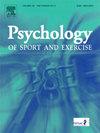How tough should the love be? The effect of varying levels of descriptive norm feedback on performance and maximum heart rate during an exercise task
IF 3.3
2区 心理学
Q2 HOSPITALITY, LEISURE, SPORT & TOURISM
引用次数: 0
Abstract
Growing evidence suggests that manipulations of descriptive norms—perceptions of the typical behaviours of others—can affect people’s exertion and performance during exercise tasks. However, no research has systematically varied the extent to which people are told they are below the norm with a view to understanding how this aspect of norm feedback affects the strength of its effects on exertion, performance, or other outcomes. In a pre-registered experiment (N = 105) with a pre-post between-subjects design and three conditions, we compared the effect of norm messages indicating that participants had performed 10%, 30%, or 50% below the norm on an exercise task. Participants first completed a baseline trial of a timed maximum effort wall sit. Then, prior to and during Trial 2, participants received feedback that their task performance was below average by one of the three amounts. Participants in the 50% condition demonstrated greater increases in their wall sit performance from Trial 1 to Trial 2 than participants in the 10% and 30% conditions. There were no significant differences between conditions in changes in maximum heart rate (a proxy for participants’ exertion). The effects of the norm feedback on performance were not underpinned by changes in either participants’ task motivation or perceived similarity to the norm reference group. Results suggest that feedback indicating a high discrepancy between one’s own performance and the norm facilitates greater performance improvements on a physically demanding task than less discrepant (and more attainable) feedback. Further research is required to understand the mechanisms underpinning this effect.
爱应该有多坚强?在运动任务中,不同水平的描述性规范反馈对表现和最大心率的影响
越来越多的证据表明,对描述性规范的操纵——对他人典型行为的感知——可以影响人们在锻炼任务中的努力和表现。然而,没有研究系统地改变人们被告知他们低于标准的程度,以了解规范反馈的这一方面如何影响其对努力,表现或其他结果的影响强度。在一项预先注册的实验(N = 105)中,我们采用了前后受试者之间的设计和三种条件,比较了表明参与者在练习任务中表现比标准低10%、30%或50%的规范信息的影响。参与者首先完成了一个计时最大力量墙坐的基线试验。然后,在试验2之前和期间,参与者收到的反馈是,他们的任务表现低于平均水平的三个量之一。从试验1到试验2,50%条件下的参与者比10%和30%条件下的参与者表现出更大的壁上静坐表现。在不同的情况下,最大心率的变化没有显著差异(代表参与者的努力程度)。规范反馈对表现的影响并不是由参与者的任务动机或与规范参照组的感知相似性的变化所支撑的。结果表明,与差异较小(但更容易获得)的反馈相比,表明自己的表现与标准之间存在较大差异的反馈,有助于在体力要求较高的任务上取得更大的表现改进。需要进一步的研究来理解支撑这种效应的机制。
本文章由计算机程序翻译,如有差异,请以英文原文为准。
求助全文
约1分钟内获得全文
求助全文
来源期刊
CiteScore
6.40
自引率
5.90%
发文量
172
审稿时长
69 days
期刊介绍:
Psychology of Sport and Exercise is an international forum for scholarly reports in the psychology of sport and exercise, broadly defined. The journal is open to the use of diverse methodological approaches. Manuscripts that will be considered for publication will present results from high quality empirical research, systematic reviews, meta-analyses, commentaries concerning already published PSE papers or topics of general interest for PSE readers, protocol papers for trials, and reports of professional practice (which will need to demonstrate academic rigour and go beyond mere description). The CONSORT guidelines consort-statement need to be followed for protocol papers for trials; authors should present a flow diagramme and attach with their cover letter the CONSORT checklist. For meta-analysis, the PRISMA prisma-statement guidelines should be followed; authors should present a flow diagramme and attach with their cover letter the PRISMA checklist. For systematic reviews it is recommended that the PRISMA guidelines are followed, although it is not compulsory. Authors interested in submitting replications of published studies need to contact the Editors-in-Chief before they start their replication. We are not interested in manuscripts that aim to test the psychometric properties of an existing scale from English to another language, unless new validation methods are used which address previously unanswered research questions.

 求助内容:
求助内容: 应助结果提醒方式:
应助结果提醒方式:


